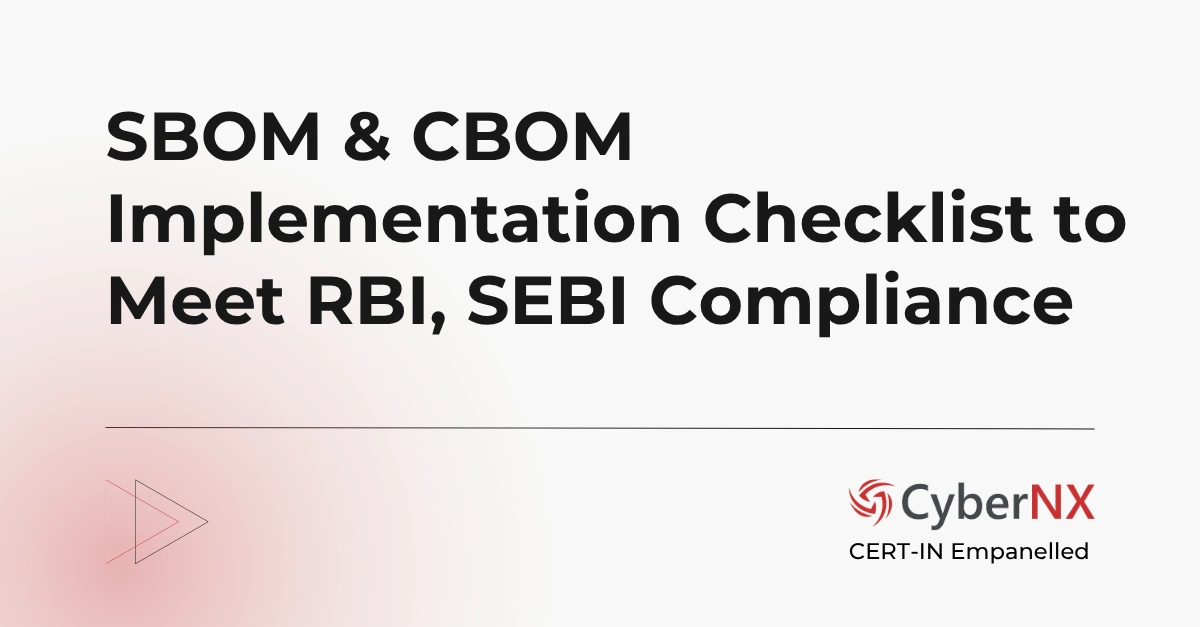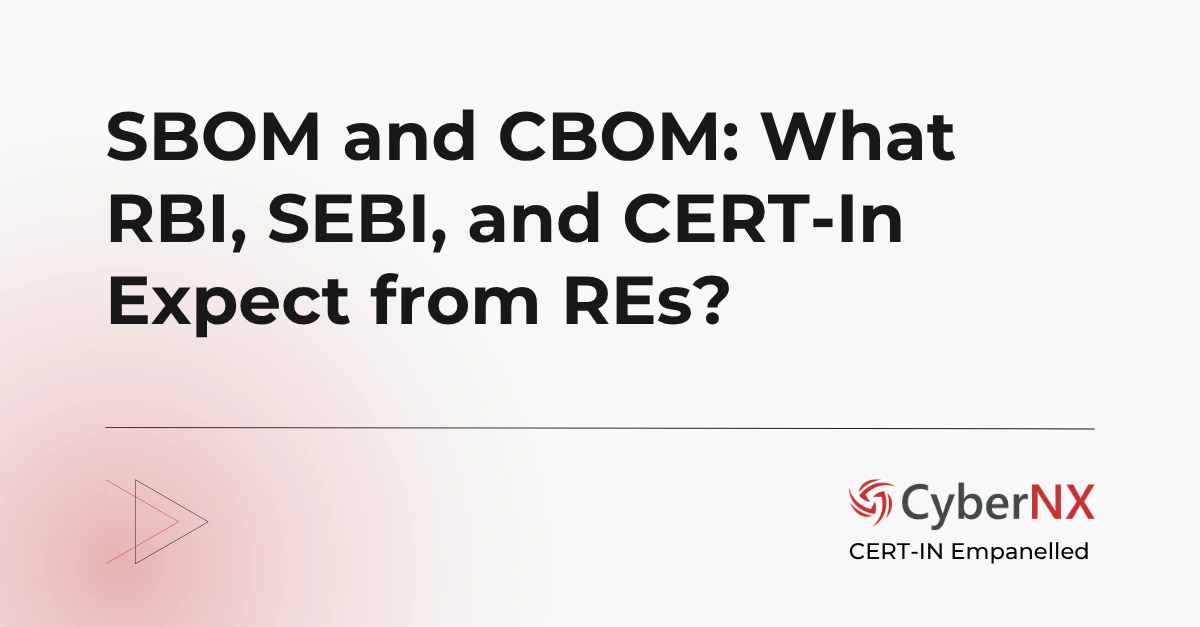While RBI has not yet issued a single consolidated SBOM-specific circular, their recent advisories, inspections, and supervisory interactions with financial institutions strongly emphasize SBOM-like capabilities, especially for critical digital infrastructure, vendor management, and incident response readiness. This is further supported by India’s national push for cyber resilience in BFSI, in alignment with CERT-In and MeitY’s security frameworks.
As cyber threats increasingly exploit hidden dependencies in software, RBI’s directives represent a proactive step toward securing financial services through transparency and risk governance. This blog explores the key requirements, documentation norms, implementation timeline, and penalties associated with RBI SBOM compliance.
Understanding RBI SBOM Compliance
First you need to know what SBOM is, and our blog SBOM Guide will help you do that. The RBI’s SBOM requirement is a strategic imperative for national financial security. With growing reliance on third-party software and open-source tools, hidden vulnerabilities can leave even the most secure systems exposed. By mandating SBOM, the RBI aims to:
- Enhance visibility into all software components, including third-party and open-source elements
- Enable faster incident response by identifying and isolating vulnerable components
- Promote accountability among software vendors and financial institutions
Key SBOM Requirements from RBI
The guidelines for RBI SBOM Compliance outlines four core areas for compliance. These form the foundation of a robust software supply chain governance program.
1. Inventory Management
Every regulated entity must maintain an up-to-date SBOM for all critical applications, listing every software component—proprietary, open-source, or third-party. This includes versioning, licensing, and source information to track components across systems.
2. Vulnerability Monitoring
Continuous monitoring of known vulnerabilities (such as those in the National Vulnerability Database) is essential. Organizations must have tools and processes in place to detect vulnerabilities as soon as they are publicly disclosed.
3. Patch Management
Identified vulnerabilities must be remediated through patches or configuration changes in a timely manner. RBI expects institutions to follow a structured patch lifecycle and document all fixes as part of compliance.
4. Risk Assessment
Periodic risk assessments must be conducted to evaluate the health of the software supply chain. This includes assessing third-party libraries, open-source packages, and vendor software to identify potential entry points for threat actors.
Implementation Timeline for RBI SBOM Compliance
RBI has set phased deadlines to allow institutions and vendors to build capability while aligning with national cybersecurity priorities.
- Critical Systems: Financial institutions were expected to implement SBOM for critical applications by Q4 2023.
- Vendor Contracts: All new vendor contracts must now include SBOM generation and risk-sharing responsibilities.
- Audits: Starting in 2024, institutions are required to undergo regular audits to verify the accuracy and completeness of their SBOM and associated risk controls.
- Board and RBI Reporting: Quarterly reports must be submitted to the board of directors and the RBI, outlining the institution’s SBOM posture, vulnerability tracking, and remediation efforts.
Mandatory Documentation for Compliance
RBI’s compliance regime is documentation-heavy to ensure verifiability and audit readiness. Every regulated entity must maintain:
- A comprehensive SBOM for all critical applications
- Vulnerability assessment reports mapped to CVEs and impact severity
- Documented patch management procedures
- Vendor risk assessment reports, especially for critical third-party tools
- A board-approved software supply chain risk policy
Each of these documents must be updated regularly and made available during regulatory audits or cyber incident reviews.
Penalties for Non-Compliance
The RBI has emphasized strict enforcement. Non-compliance may result in a range of consequences that can impact both operations and reputation:
- Monetary penalties up to ₹1 crore for significant violations
- Increased regulatory scrutiny and reporting obligations
- Business restrictions including delays in product rollouts
- Mandatory third-party audits ordered by the RBI
- Public disclosure of non-compliance, which could damage trust and reputation
How to Prepare for RBI SBOM Compliance?
To get ahead of the RBI SBOM compliance curve, regulated entities should:
- Invest in automated SBOM generation tools like NXHawk Syft, CycloneDX CLI, or FOSSA. Read our blog Top 5 SBOM Tools to know more
- Create a centralized software inventory with versioning and dependency mapping
- Integrate SBOM generation into CI/CD pipelines for ongoing compliance
- Establish a governance team responsible for vulnerability management and policy enforcement
- Work with vendors who demonstrate SBOM readiness and agree to RBI-aligned terms
Conclusion
RBI SBOM Compliance mandate is a wake-up call for India’s financial sector to take software supply chain security seriously. As digital transformation accelerates, institutions that embrace transparency, automation, and governance will not only stay compliant but also build long-term trust with stakeholders.
Rather than seeing SBOM as a compliance burden, organizations should view it as a strategic cybersecurity asset—one that ensures faster response to vulnerabilities, better vendor management, and a stronger security posture in an increasingly interconnected world.
Our advanced SBOM tool can help your organisation to stay secure. Plus, it ensures compliance with different regulatory bodies like SEBI, RBI, CERT-In all the time. To know more about how we can help you generate and manage SBOMs, contact us today.
RBI SBOM Compliance FAQs
Can legacy systems be exempt from RBI SBOM Compliance requirements?
No, RBI has not provided specific exemptions for legacy systems. However, institutions may face practical challenges in generating SBOMs for older applications lacking source control or documentation. In such cases, RBI expects entities to document their limitations, adopt best-effort inventory practices (like binary analysis), and develop a phased plan to bring legacy systems into compliance.
How should financial institutions evaluate third-party vendors for RBI SBOM compliance?
Institutions must assess vendors on their ability to generate, maintain, and share SBOMs in machine-readable formats. Evaluation criteria should include the vendor’s transparency around software dependencies, their vulnerability disclosure practices, update frequency, and support for standards like SPDX or CycloneDX. RBI encourages inclusion of SBOM clauses in procurement and vendor risk contracts.
What SBOM formats are acceptable for compliance with RBI guidelines?
While RBI hasn’t mandated a specific format, industry-standard SBOM formats like SPDX, CycloneDX, and SWID are considered acceptable. These formats support automation, interoperability, and version control—making them suitable for long-term compliance tracking, audit readiness, and integration with CI/CD pipelines.
How frequently should the SBOM be updated to remain compliant?
RBI expects SBOMs to be updated at every major software release, patch, or dependency change. Additionally, regulated entities should conduct quarterly reviews to validate their software inventory, remove outdated components, and align their SBOM with current production environments. Real-time SBOM generation through DevSecOps practices is strongly recommended for dynamic applications.





